Hyundai Grand Santa Fe 2014 Repair Manual
Manufacturer: HYUNDAI, Model Year: 2014, Model line: Grand Santa Fe, Model: Hyundai Grand Santa Fe 2014Pages: 718, PDF Size: 13.5 MB
Page 61 of 718
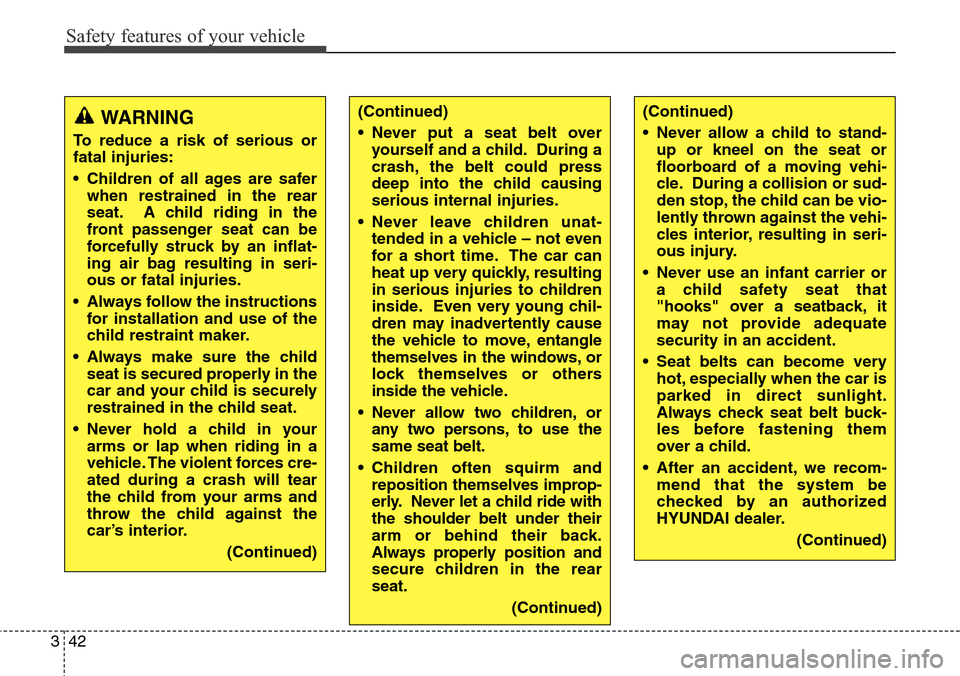
Safety features of your vehicle
42 3
WARNING
To reduce a risk of serious or
fatal injuries:
• Children of all ages are safer
when restrained in the rear
seat. A child riding in the
front passenger seat can be
forcefully struck by an inflat-
ing air bag resulting in seri-
ous or fatal injuries.
• Always follow the instructions
for installation and use of the
child restraint maker.
• Always make sure the child
seat is secured properly in the
car and your child is securely
restrained in the child seat.
• Never hold a child in your
arms or lap when riding in a
vehicle. The violent forces cre-
ated during a crash will tear
the child from your arms and
throw the child against the
car’s interior.
(Continued)
(Continued)
• Never put a seat belt over
yourself and a child. During a
crash, the belt could press
deep into the child causing
serious internal injuries.
• Never leave children unat-
tended in a vehicle – not even
for a short time. The car can
heat up very quickly, resulting
in serious injuries to children
inside. Even very young chil-
dren may inadvertently cause
the vehicle to move, entangle
themselves in the windows, or
lock themselves or others
inside the vehicle.
• Never allow two children, or
any two persons, to use the
same seat belt.
• Children often squirm and
reposition themselves improp-
erly. Never let a child ride with
the shoulder belt under their
arm or behind their back.
Always properly position and
secure children in the rear
seat.
(Continued)(Continued)
• Never allow a child to stand-
up or kneel on the seat or
floorboard of a moving vehi-
cle. During a collision or sud-
den stop, the child can be vio-
lently thrown against the vehi-
cles interior, resulting in seri-
ous injury.
• Never use an infant carrier or
a child safety seat that
"hooks" over a seatback, it
may not provide adequate
security in an accident.
• Seat belts can become very
hot, especially when the car is
parked in direct sunlight.
Always check seat belt buck-
les before fastening them
over a child.
• After an accident, we recom-
mend that the system be
checked by an authorized
HYUNDAI dealer.
(Continued)
Page 62 of 718
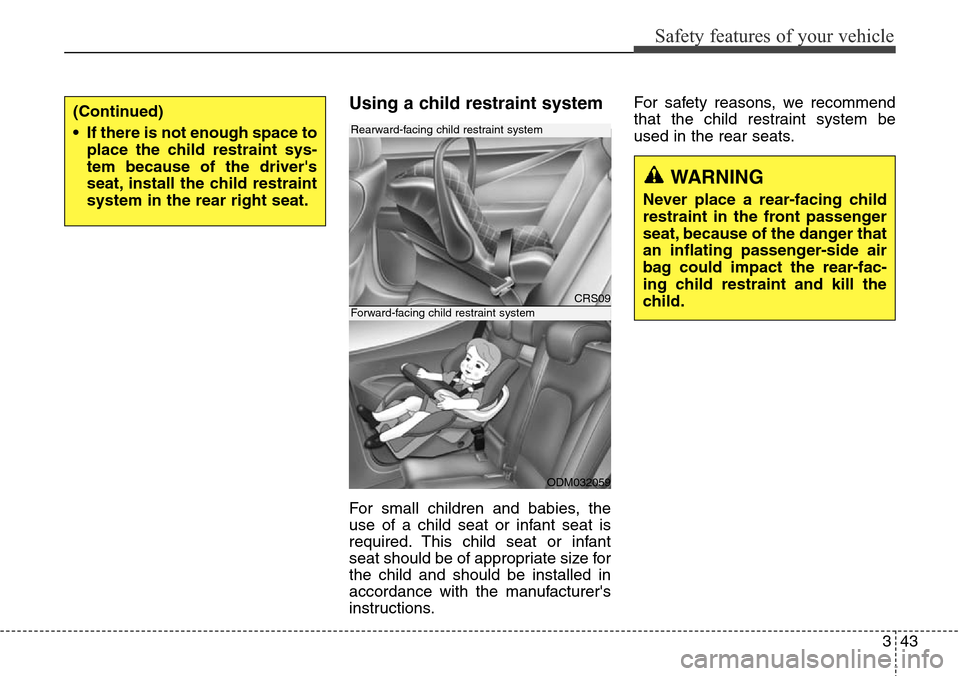
343
Safety features of your vehicle
Using a child restraint system
For small children and babies, the
use of a child seat or infant seat is
required. This child seat or infant
seat should be of appropriate size for
the child and should be installed in
accordance with the manufacturer's
instructions.For safety reasons, we recommend
that the child restraint system be
used in the rear seats.
CRS09
ODM032059
Rearward-facing child restraint system
Forward-facing child restraint system
(Continued)
• If there is not enough space to
place the child restraint sys-
tem because of the driver's
seat, install the child restraint
system in the rear right seat.
WARNING
Never place a rear-facing child
restraint in the front passenger
seat, because of the danger that
an inflating passenger-side air
bag could impact the rear-fac-
ing child restraint and kill the
child.
Page 63 of 718
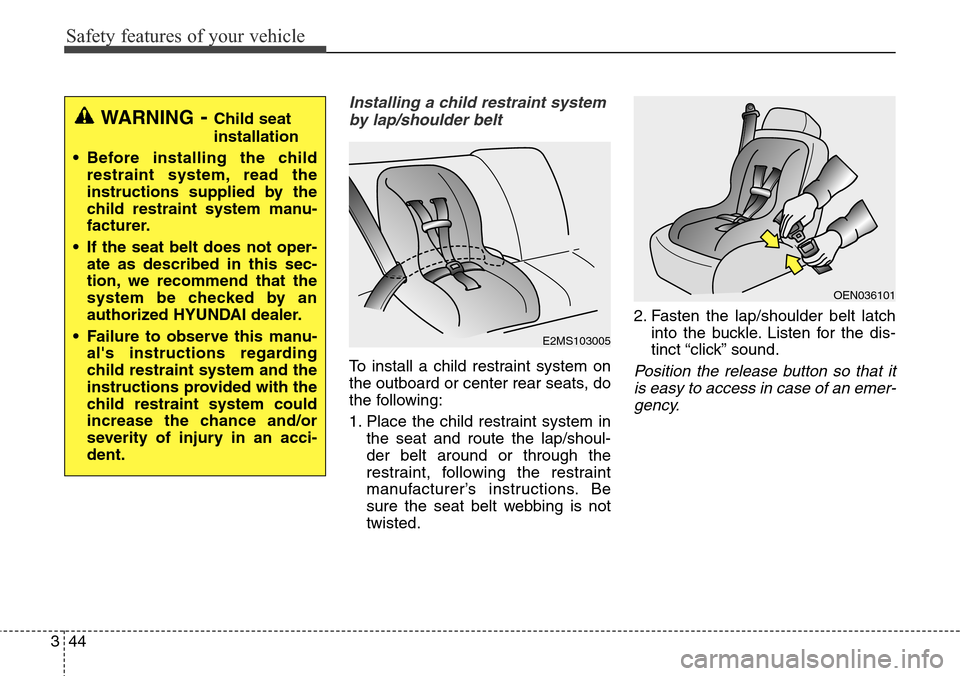
Safety features of your vehicle
44 3
Installing a child restraint system
by lap/shoulder belt
To install a child restraint system on
the outboard or center rear seats, do
the following:
1. Place the child restraint system in
the seat and route the lap/shoul-
der belt around or through the
restraint, following the restraint
manufacturer’s instructions. Be
sure the seat belt webbing is not
twisted.2. Fasten the lap/shoulder belt latch
into the buckle. Listen for the dis-
tinct “click” sound.Position the release button so that it
is easy to access in case of an emer-
gency.
E2MS103005
OEN036101
WARNING- Child seat
installation
• Before installing the child
restraint system, read the
instructions supplied by the
child restraint system manu-
facturer.
• If the seat belt does not oper-
ate as described in this sec-
tion, we recommend that the
system be checked by an
authorized HYUNDAI dealer.
• Failure to observe this manu-
al's instructions regarding
child restraint system and the
instructions provided with the
child restraint system could
increase the chance and/or
severity of injury in an acci-
dent.
Page 64 of 718
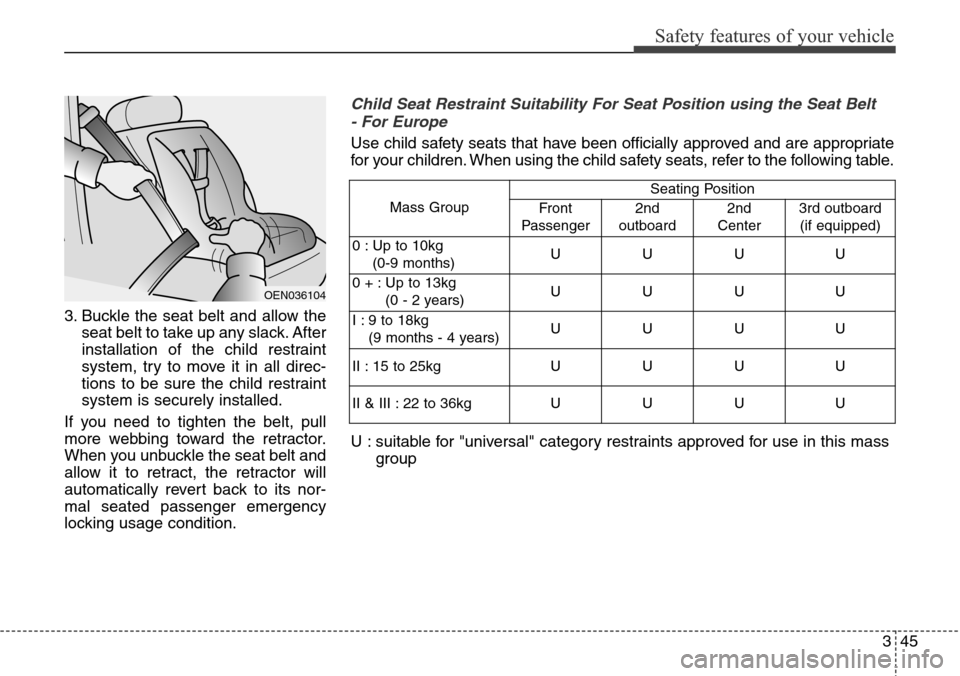
345
Safety features of your vehicle
3. Buckle the seat belt and allow the
seat belt to take up any slack. After
installation of the child restraint
system, try to move it in all direc-
tions to be sure the child restraint
system is securely installed.
If you need to tighten the belt, pull
more webbing toward the retractor.
When you unbuckle the seat belt and
allow it to retract, the retractor will
automatically revert back to its nor-
mal seated passenger emergency
locking usage condition.
OEN036104
Child Seat Restraint Suitability For Seat Position using the Seat Belt
- For Europe
Use child safety seats that have been officially approved and are appropriate
for your children. When using the child safety seats, refer to the following table.
U : suitable for "universal" category restraints approved for use in this mass
group
Mass GroupSeating Position
Front
Passenger2nd
outboard2nd
Center3rd outboard
(if equipped)
0 : Up to 10kg
(0-9 months)UUU U
0 + : Up to 13kg
(0 - 2 years)UUU U
I : 9 to 18kg
(9 months - 4 years)UUU U
II : 15 to 25kg U U U U
II & III : 22 to 36kg U U U U
Page 65 of 718
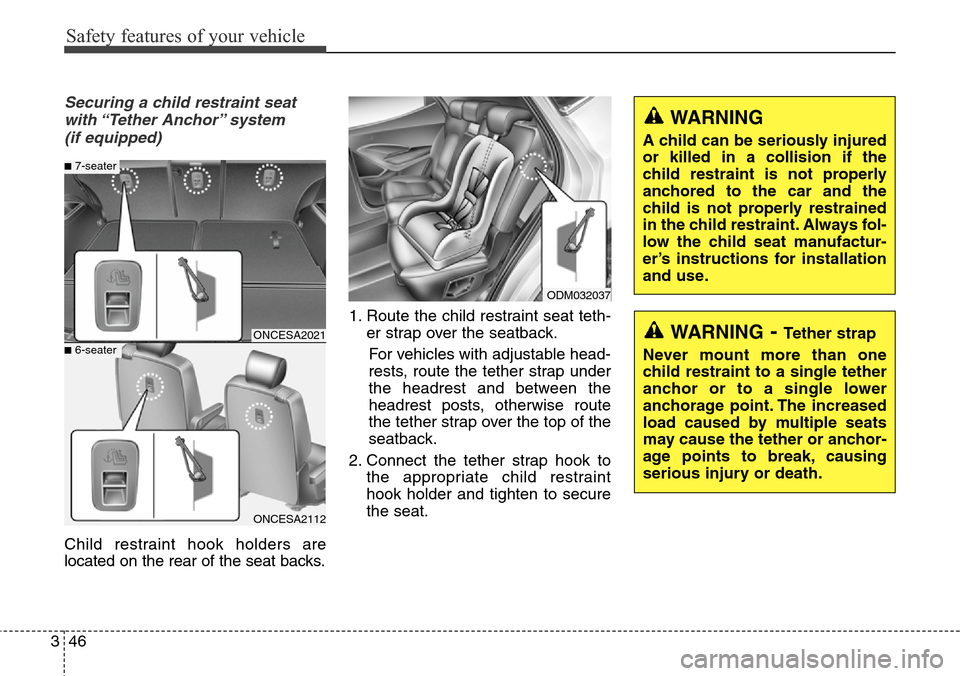
Safety features of your vehicle
46 3
WARNING- Tether strap
Never mount more than one
child restraint to a single tether
anchor or to a single lower
anchorage point. The increased
load caused by multiple seats
may cause the tether or anchor-
age points to break, causing
serious injury or death.
WARNING
A child can be seriously injured
or killed in a collision if the
child restraint is not properly
anchored to the car and the
child is not properly restrained
in the child restraint. Always fol-
low the child seat manufactur-
er’s instructions for installation
and use.
Securing a child restraint seat
with “Tether Anchor” system
(if equipped)
Child restraint hook holders are
located on the rear of the seat backs.1. Route the child restraint seat teth-
er strap over the seatback.
For vehicles with adjustable head-
rests, route the tether strap under
the headrest and between the
headrest posts, otherwise route
the tether strap over the top of the
seatback.
2. Connect the tether strap hook to
the appropriate child restraint
hook holder and tighten to secure
the seat.
ODM032037
ONCESA2021
■7-seater
■6-seater
ONCESA2112
Page 66 of 718
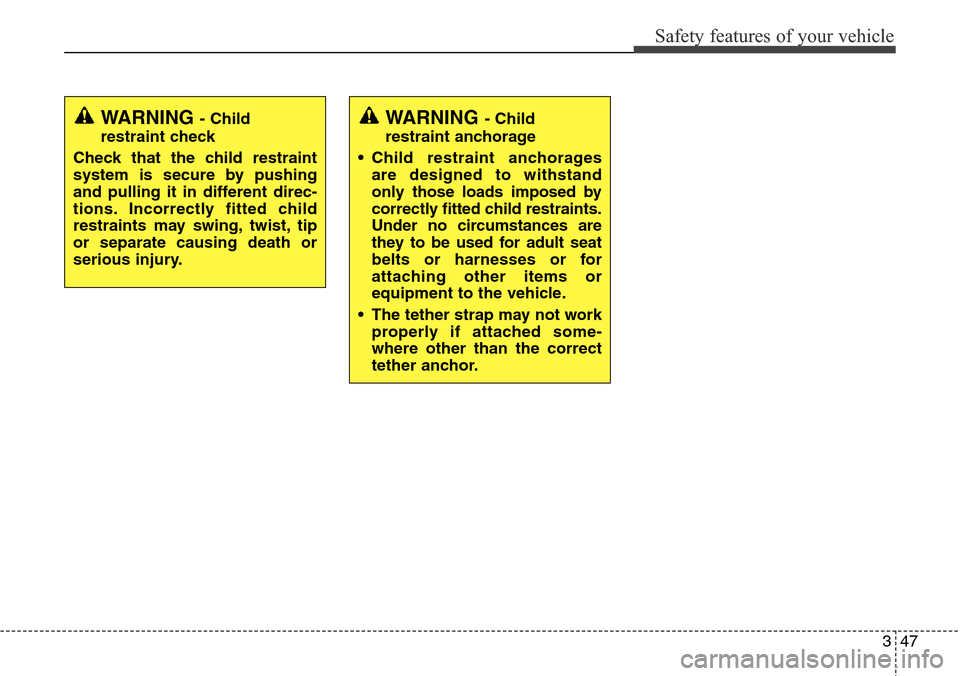
347
Safety features of your vehicle
WARNING - Child
restraint check
Check that the child restraint
system is secure by pushing
and pulling it in different direc-
tions. Incorrectly fitted child
restraints may swing, twist, tip
or separate causing death or
serious injury.WARNING - Child
restraint anchorage
• Child restraint anchorages
are designed to withstand
only those loads imposed by
correctly fitted child restraints.
Under no circumstances are
they to be used for adult seat
belts or harnesses or for
attaching other items or
equipment to the vehicle.
• The tether strap may not work
properly if attached some-
where other than the correct
tether anchor.
Page 67 of 718
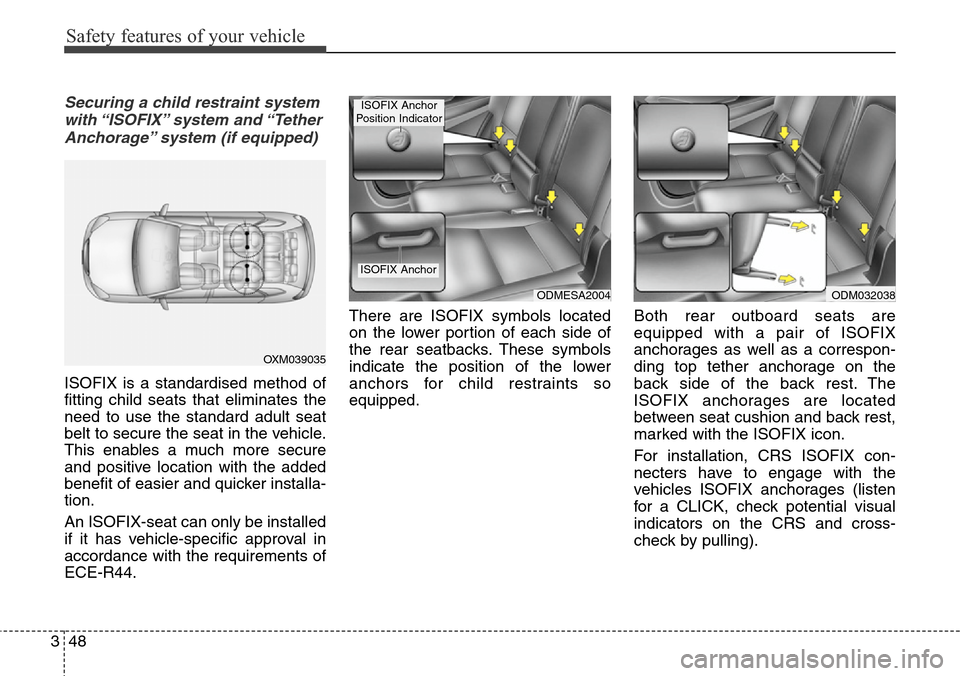
Safety features of your vehicle
48 3
Securing a child restraint system
with “ISOFIX” system and “Tether
Anchorage” system (if equipped)
ISOFIX is a standardised method of
fitting child seats that eliminates the
need to use the standard adult seat
belt to secure the seat in the vehicle.
This enables a much more secure
and positive location with the added
benefit of easier and quicker installa-
tion.
An ISOFIX-seat can only be installed
if it has vehicle-specific approval in
accordance with the requirements of
ECE-R44.There are ISOFIX symbols located
on the lower portion of each side of
the rear seatbacks. These symbols
indicate the position of the lower
anchors for child restraints so
equipped.Both rear outboard seats are
equipped with a pair of ISOFIX
anchorages as well as a correspon-
ding top tether anchorage on the
back side of the back rest. The
ISOFIX anchorages are located
between seat cushion and back rest,
marked with the ISOFIX icon.
For installation, CRS ISOFIX con-
necters have to engage with the
vehicles ISOFIX anchorages (listen
for a CLICK, check potential visual
indicators on the CRS and cross-
check by pulling).
OXM039035
ODMESA2004
ISOFIX Anchor
ISOFIX Anchor
Position Indicator
ODM032038
Page 68 of 718
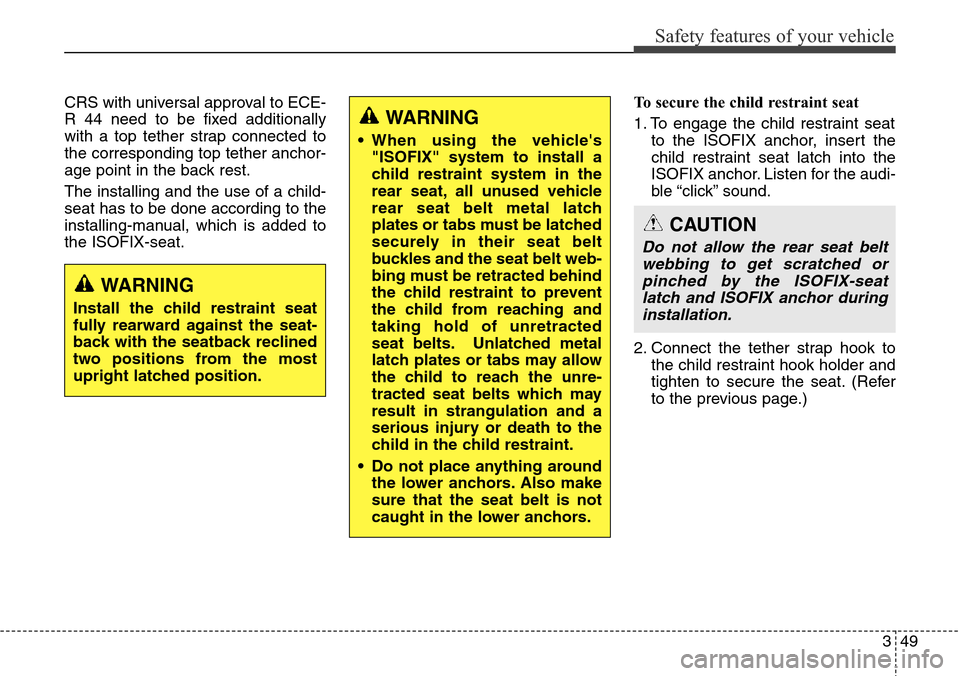
349
Safety features of your vehicle
CRS with universal approval to ECE-
R 44 need to be fixed additionally
with a top tether strap connected to
the corresponding top tether anchor-
age point in the back rest.
The installing and the use of a child-
seat has to be done according to the
installing-manual, which is added to
the ISOFIX-seat.To secure the child restraint seat
1. To engage the child restraint seat
to the ISOFIX anchor, insert the
child restraint seat latch into the
ISOFIX anchor. Listen for the audi-
ble “click” sound.
2. Connect the tether strap hook to
the child restraint hook holder and
tighten to secure the seat. (Refer
to the previous page.)
WARNING
Install the child restraint seat
fully rearward against the seat-
back with the seatback reclined
two positions from the most
upright latched position.
WARNING
• When using the vehicle's
"ISOFIX" system to install a
child restraint system in the
rear seat, all unused vehicle
rear seat belt metal latch
plates or tabs must be latched
securely in their seat belt
buckles and the seat belt web-
bing must be retracted behind
the child restraint to prevent
the child from reaching and
taking hold of unretracted
seat belts. Unlatched metal
latch plates or tabs may allow
the child to reach the unre-
tracted seat belts which may
result in strangulation and a
serious injury or death to the
child in the child restraint.
• Do not place anything around
the lower anchors. Also make
sure that the seat belt is not
caught in the lower anchors.
CAUTION
Do not allow the rear seat belt
webbing to get scratched or
pinched by the ISOFIX-seat
latch and ISOFIX anchor during
installation.
Page 69 of 718
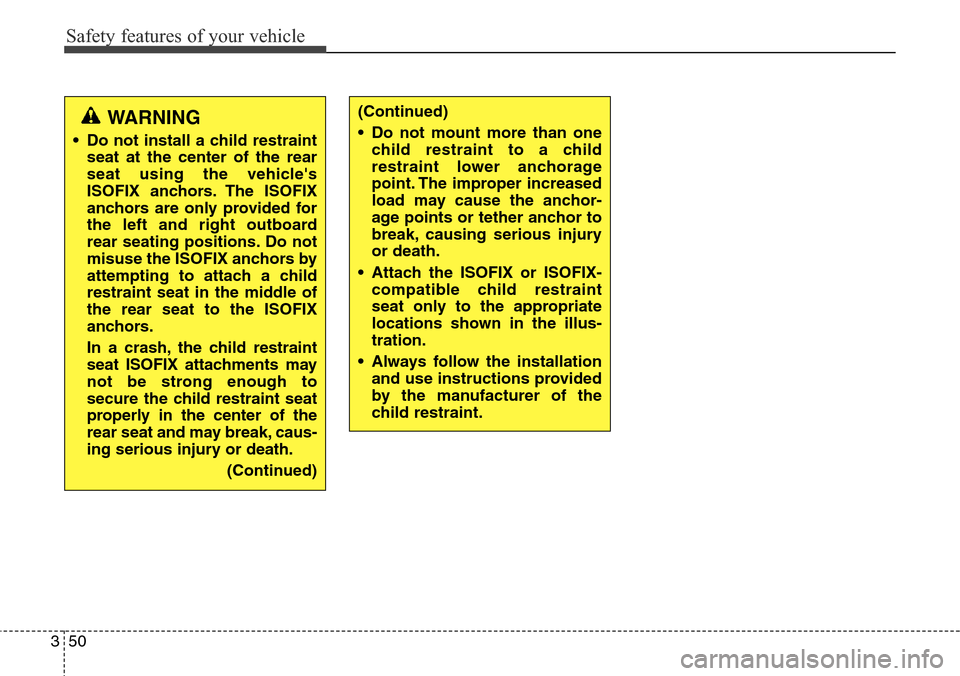
Safety features of your vehicle
50 3
(Continued)
• Do not mount more than one
child restraint to a child
restraint lower anchorage
point. The improper increased
load may cause the anchor-
age points or tether anchor to
break, causing serious injury
or death.
• Attach the ISOFIX or ISOFIX-
compatible child restraint
seat only to the appropriate
locations shown in the illus-
tration.
• Always follow the installation
and use instructions provided
by the manufacturer of the
child restraint.WARNING
• Do not install a child restraint
seat at the center of the rear
seat using the vehicle's
ISOFIX anchors. The ISOFIX
anchors are only provided for
the left and right outboard
rear seating positions. Do not
misuse the ISOFIX anchors by
attempting to attach a child
restraint seat in the middle of
the rear seat to the ISOFIX
anchors.
In a crash, the child restraint
seat ISOFIX attachments may
not be strong enough to
secure the child restraint seat
properly in the center of the
rear seat and may break, caus-
ing serious injury or death.
(Continued)
Page 70 of 718
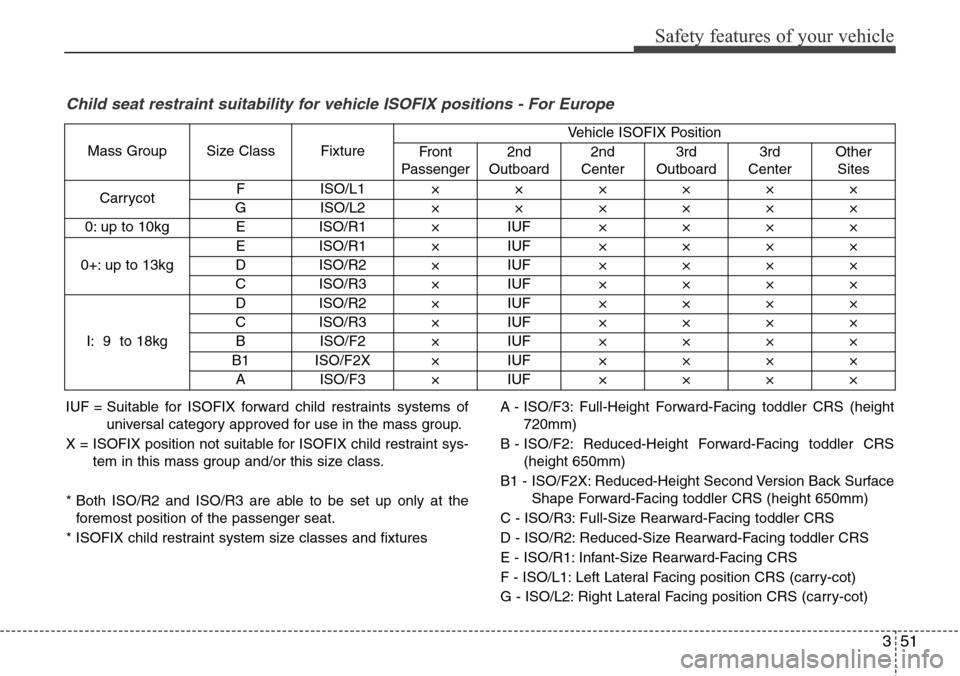
351
Safety features of your vehicle
Child seat restraint suitability for vehicle ISOFIX positions - For Europe
IUF = Suitable for ISOFIX forward child restraints systems of
universal category approved for use in the mass group.
X = ISOFIX position not suitable for ISOFIX child restraint sys-
tem in this mass group and/or this size class.
* Both ISO/R2 and ISO/R3 are able to be set up only at the
foremost position of the passenger seat.
* ISOFIX child restraint system size classes and fixturesA - ISO/F3: Full-Height Forward-Facing toddler CRS (height
720mm)
B - ISO/F2: Reduced-Height Forward-Facing toddler CRS
(height 650mm)
B1 - ISO/F2X: Reduced-Height Second Version Back Surface
Shape Forward-Facing toddler CRS (height 650mm)
C - ISO/R3: Full-Size Rearward-Facing toddler CRS
D - ISO/R2: Reduced-Size Rearward-Facing toddler CRS
E - ISO/R1: Infant-Size Rearward-Facing CRS
F - ISO/L1: Left Lateral Facing position CRS (carry-cot)
G - ISO/L2: Right Lateral Facing position CRS (carry-cot) Mass Group Size Class FixtureVehicle ISOFIX Position
Front
Passenger2nd
Outboard2nd
Center3rd
Outboard3rd
CenterOther
Sites
Carrycot F ISO/L1××××××
G ISO/L2××××××
0: up to 10kg E ISO/R1 × IUF××××
0+: up to 13kgE ISO/R1 × IUF××××
D ISO/R2 × IUF××××
C ISO/R3 × IUF××××
I: 9 to 18kgD ISO/R2 × IUF××××
C ISO/R3 × IUF××××
BISO/F2×IUF××××
B1 ISO/F2X × IUF××××
AISO/F3×IUF××××